Tendre fish fillet poached in seasoned water, then topped with spices, Sichuan boiled fish is tasty, pungent and super addictive.
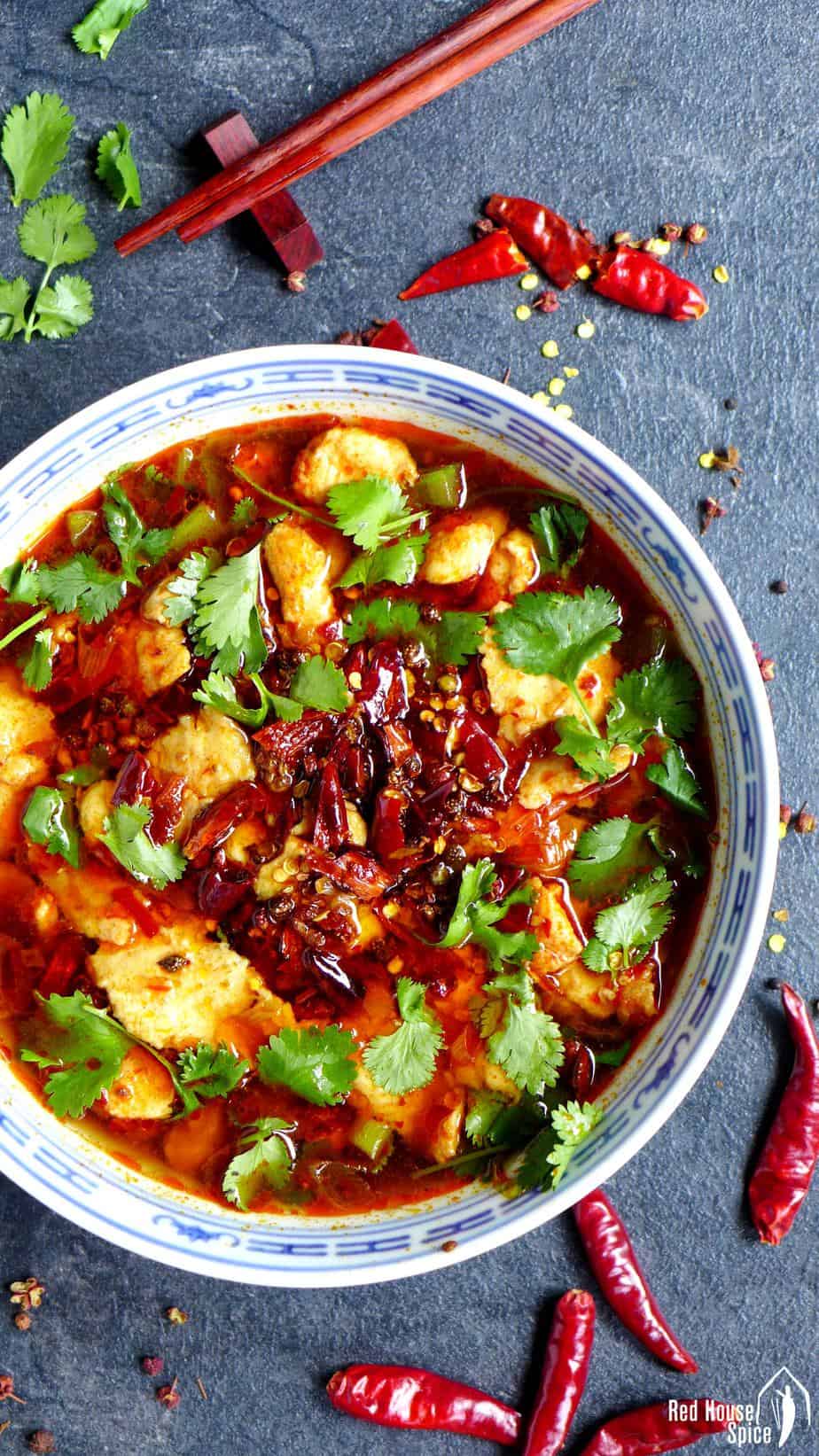
I still remember exactly where I ate Sichuan boiled fish (Shui Zhu Yu, 水煮鱼) for the first time. It was a tiny little restaurant specializing in Sichuan cuisine hidden in a quiet neighbourhood of Beijing. At that moment, I only knew a few famous Sichuan dishes, such as Mapo tofu, Kong Pao chicken, Shredded pork with garlic sauce, etc.. I found Sichuan boiled fish so stunning that later on it became the one dish that I always order whenever it’s on the menu.
It’s tender & succulent
Literally, the Chinese name of Sichuan boil fish “Shui Zhu Yu (水煮鱼)” means water boiled fish. The marinated fish slices are poached briefly in seasoned water. They taste very tender, succulent and packed with flavour.
To achieve the best result, I recommend you use fresh fillets instead of frozen ones. In China, restaurants often have fish tanks from which the customers can choose live fish to be freshly prepared for this dish (Don’t fancy fish, try Sichuan Boiled Beef instead).
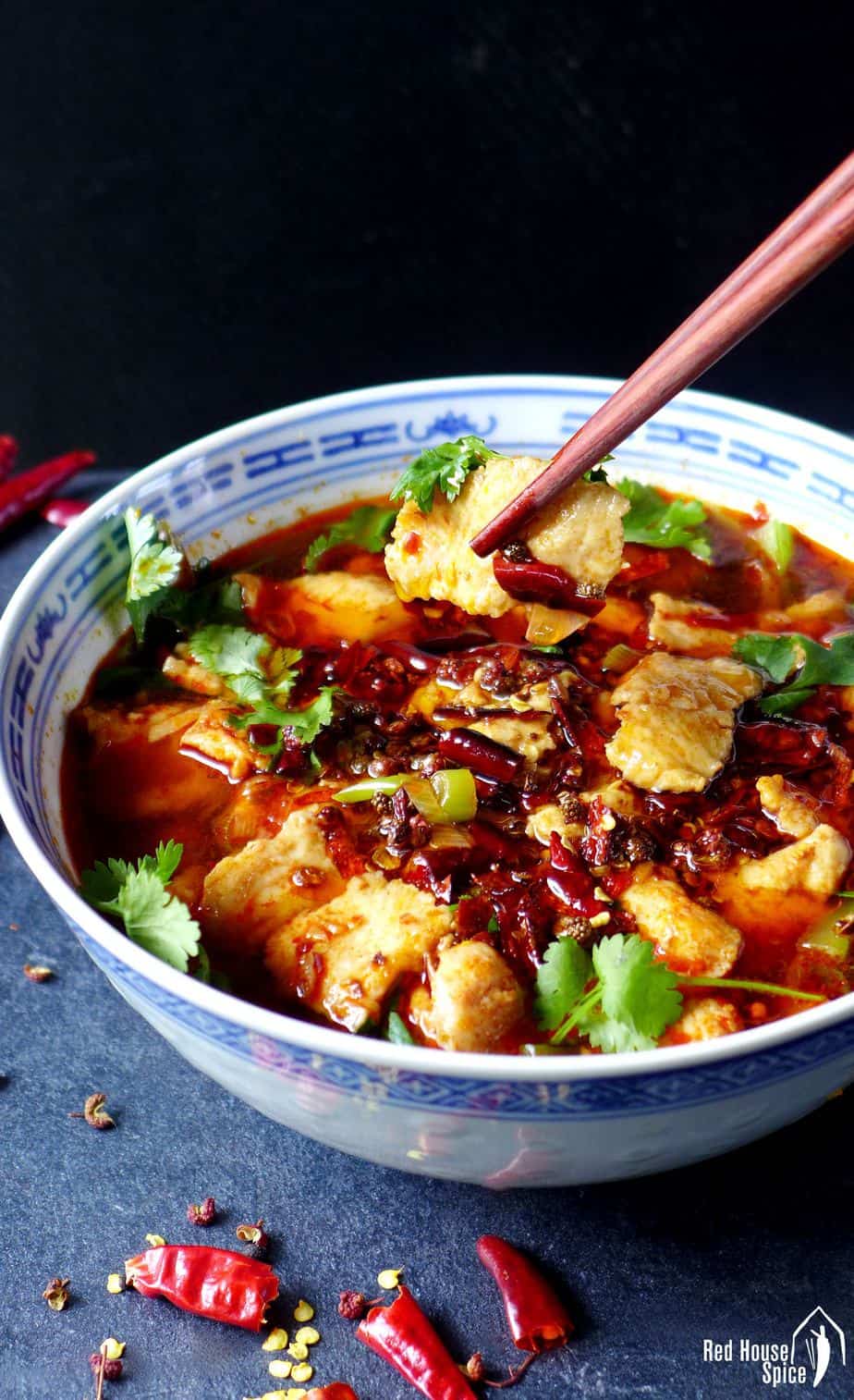
It’s super spicy
As one of the most pungent Chinese dishes, authentic Sichuan boiled fish is famous for its hotness. My friend Junyang adored this dish but unfortunately, she has a low tolerance for spicy food. She used to rinse the fish in a glass of water to reduce the hotness. And little by little she has eventually increased her tolerance.
In my recipe, you can see that the spiciness comes from the generous use of 3 ingredients: dried chilli, Sichuan chilli bean paste and chilli powder.
It gives you a numbing sensation
Sichuan boiled fish is also pungent in another way: it delivers an intensive numbing sensation to your mouth by using quite a lot of Sichuan pepper (it’s an acquired taste but very addictive once you become accustomed to it).
You might have heard or used regular Sichuan pepper (Huajiao, 花椒) which is red in colour. In fact, there is another type of Sichuan pepper called Majiao (麻椒) which has the same shape and size but is green in colour. It’s often used in Sichuan boiled fish to enhance the fragrance. However, you can use regular Sichuan pepper if you can’t find the green ones.
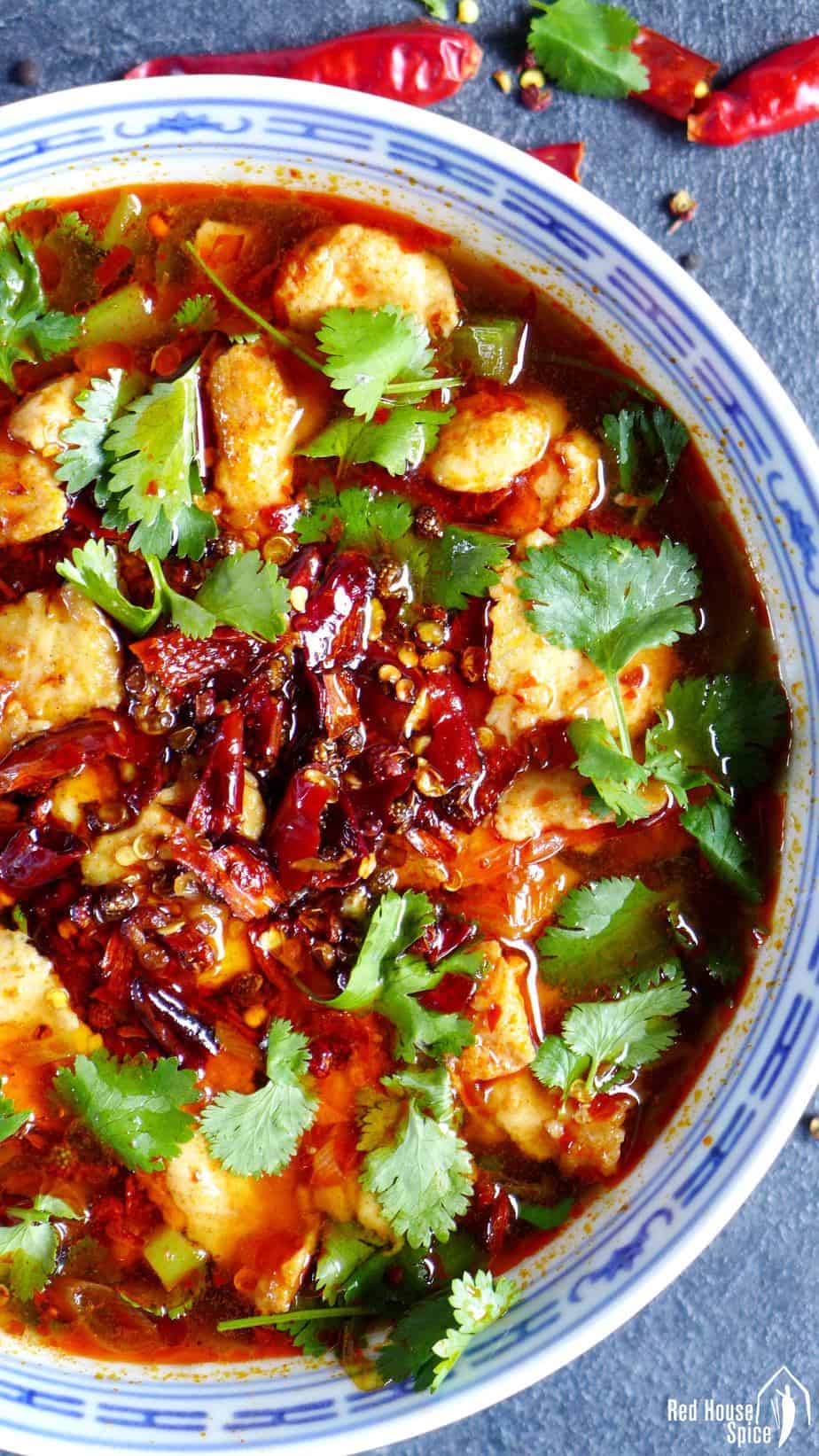
It’s easy to cook!
Many people find it intimidating to cook Sichuan boiled fish at home. I was one of them until I had a try. It’s pretty straight forward. There’s no particular cooking skill involved. As long as you have all the ingredients to hand and follow a detailed, well-written recipe, nothing will go wrong.



When reading the recipe card below, you will notice that I put ingredients in several groups. This corresponds to different cooking steps. Please note that cooking oil is listed in different groups for various purpose. The finished dish doesn’t taste greasy despite the generous use of oil. The oil is essential to draw out the full fragrance of the spices.
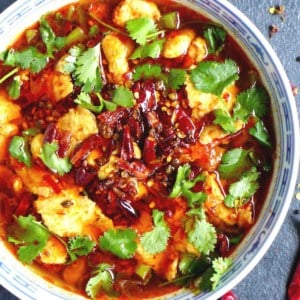
Sichuan boiled fish (Shui Zhu Yu, 水煮鱼)
Ingredients
For the fish
- 250 g skinless, boneless fish fillet - 9oz (see note 1)
- 1 pinch salt
- 1 pinch white pepper
- 1 teaspoon Shaoxing rice wine
- 1 teaspoon corn starch
For the spices
- ½ teaspoon cooking oil
- 15 dried chilli
- 2 teaspoon Sichuan peppercorn - see note 2
For the vegetable
- 1 teaspoon cooking oil
- 250 g celery, cut into thin strips - or bean sprouts
For the broth
- 2 tablespoon cooking oil
- 2 clove garlic - minced
- 1 teaspoon ginger - minced
- 1 stalk scallions - chopped
- 1.5 tablespoon Sichuan chilli bean paste - see note 3
- 1 teaspoon chilli powder
- 400 ml hot water - or chicken stock
For garnishing
- Coriander - chopped
- 2 tablespoon cooking oil
Instructions
Marinate the fish
- Slice the fish fillet diagonally. Marinate with salt, white pepper, rice wine & corn starch.
Fry the spices
- In a wok (or a deep frying pan), fry dried chilli and Sichuan pepper in oil over a low heat until fragrant (do not burn them). Chop coarsely when cooled. Set aside.
Cook the vegetable
- In the same wok, heat up oil over a medium heat, stir in celery. Cook for 1.5 minutes or so (30 seconds if using bean sprouts instead). Transfer to a serving bowl. Set aside.
Make the broth
- Heat up oil in the wok, fry garlic, ginger and spring onion. Add Sichuan chilli bean paste and chilli powder. Pour in water (or chicken stock). Bring it to a full boil.
Cook the fish
- Gently place the fish slices into the wok. When cooked, pour the fish and the soup onto the vegetable.
Garnishing
- Top with fried spices and coriander. Heat up oil then pour over to sizzle the spices. Serve immediately with plain rice.
NOTES
NUTRITION
NUTRITION DISCLOSURE: Nutritional information on this website is provided as a courtesy to readers. It should be considered estimates. Please use your own brand nutritional values or your preferred nutrition calculator to double check against our estimates.



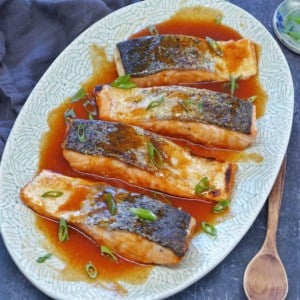
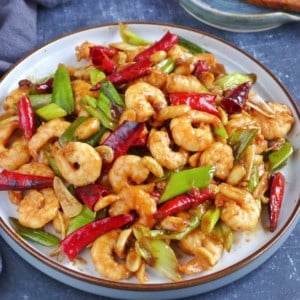
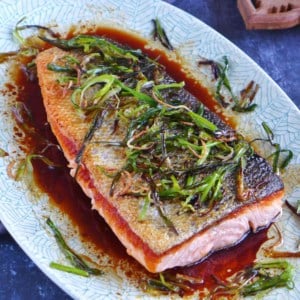
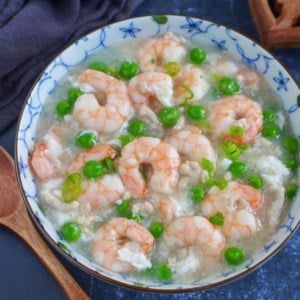
DELICIOUS!! Thank you for sharing this recipe with us. When you say chili powder do you mean gochugaru or standard chili powder?
In my recipes, chili powder refers to finely ground dried chili which doesn’t contain salt or other spices. You can use gochugaru which is Korean-style ground chili.
This is one of the best dishes in the world. I fortunately have multiple excellent places to obtain this from where I live!
It’s great to now have a recipe for it!
Hope you’ll enjoy the home version too!
Whenever I go to a Sichuan restaurant, I order this, I finally worked up the courage to make it myself. It’s so freaking good .. this is my new go to. Although I didn’t see the directions on how long to cook it so my fish overcooked a tiny bit. The fish cooks fasssst. Still delicious, great recipe
Yes, fish cooks very fast and the cooking time depends on the type of the fish. Very happy you enjoyed the dish.
I made this recipe recently and I doubled it as I.was having guests over. It was all gone! Absolutely delicious. Thank you. I made the da panji the same day. Also devoured. Thank God for your recipes.
That’s wonderful to hear Saulat!
I’ve made this recipe twice now and it has become a go to that I prepare for my family. I’ve used both cat fish and cod. Both are fine. The flavor comes together very nice.
Thanks Kimberly for trying out the recipe and leaving a feedback!
Easy to understand, I cannot wait to make this for my husband!
Happy cooking!
Hi Wei, could you provide a recipe for 酸菜鱼? I read that the cooking process is similar to 水煮鱼。
Yes Rebecca, pickled vegetable fish (酸菜鱼) is on my to-write list.
Ata Marie Wei {that’s Maori for Good morning)
For the second time I have cooked Shui Zhu Yu!
This time I way dialed back on the dried chillis and the Sichuan pepper corns! And no chilli powder! As needs must, some substitutions: I had no celery but did have mung sprouts (insufficient). Stems of Chinese broccoli filled the bill. And the leaves added at the end in the broth.
As an elderly white male who has eaten “European hot” for years, I got those ingredients right for me! I have cooked your recipes for a couple of years now.
None have disappointed!
I’ve been cooking your recipes for 2 years. They never fail to inspire me!
So interesting to read your detailed report SteveF! Very happy you find my recipes helpful.
Kia ora from NZ, Wei
I cooked Sichuan Boiled Fish last night. I had all the ingredients so no substitution required! NZ Ling (Hokarari) was a very appropriate white fish for this recipe.
The texture and taste were superb!
I will cook it again soon!
Next time I will heavily dial back on the dried chillies and the whole Sichuan peppercorns, but I did get the numbed lip and tongue effect!
Glad you liked the dish. Yes, please feel free to adjust the spice quantity.